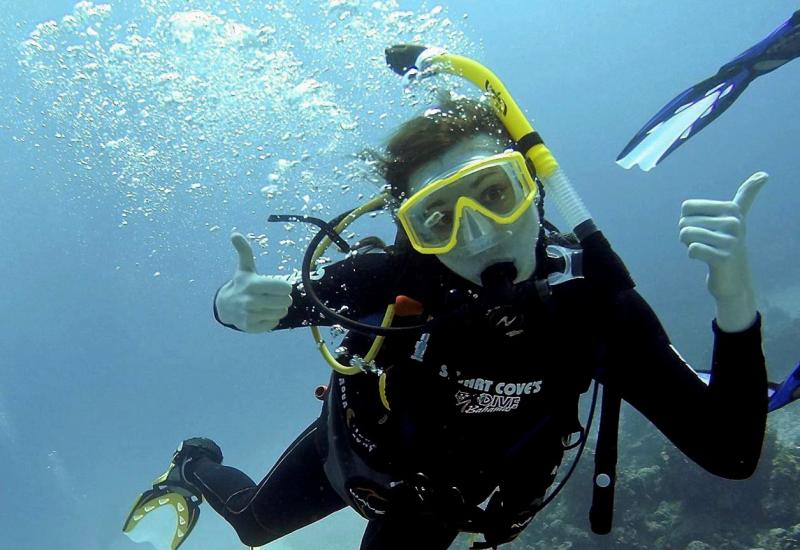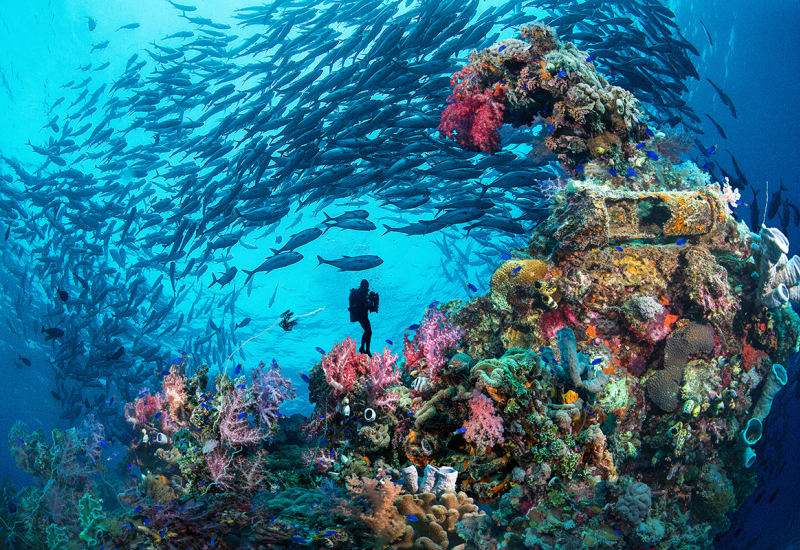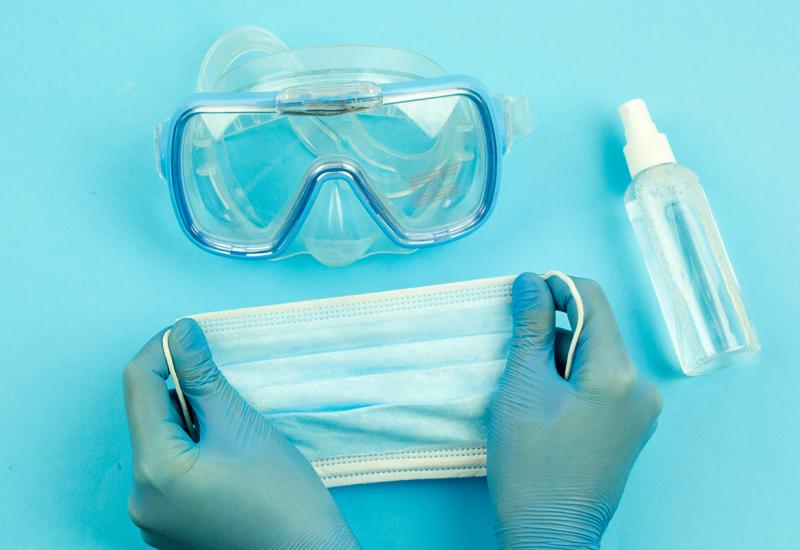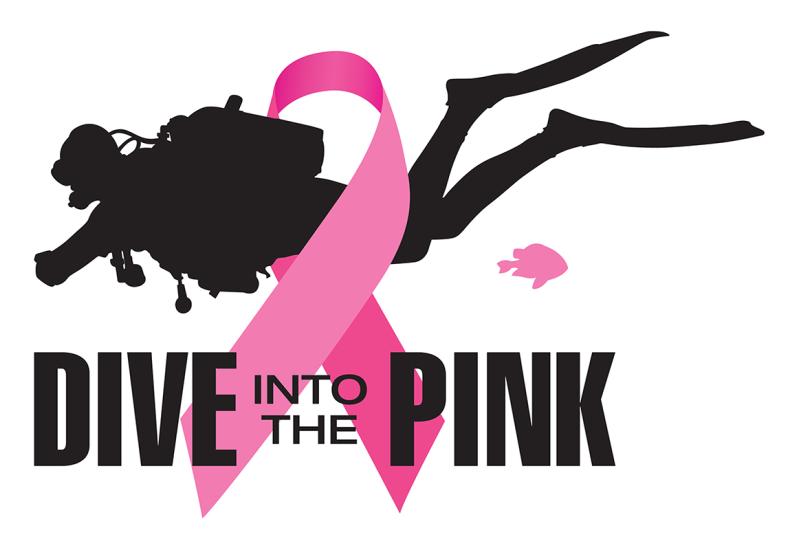Ask An Instructor - August 2008
By Michael Ange
I wear a goatee-style beard, and water often leaks into my mask from below my nose. I have to clear my mask over and over again, and it's getting frustrating. Is there anything I can do--short of shaving my goatee completely?
A: Anything that breaks your mask seal will cause leakage, so the trick is to improve the seal as much as possible. Typically, the most bothersome area is the space directly below the nose. Lower down on the upper lip, the hair usually lays flatter and causes less interference with the mask. So, one solution is to shave a thin line between your mustache and nose. Another option is to coat your mustache with Vaseline or a soft mustache wax, which can fill the spaces between the hairs and allow for a tighter seal. Finally, there are some masks with dual seals, which extend under the nose, or wide seals made of extremely soft silicone rubber that do a reasonable job of sealing without any of the above steps. But honestly, I have a mustache and find that none of these solutions work for me--some because I prefer not to use them and the others just don't work consistently. Ultimately, I just decided to get the best sealing mask possible, live with a little leakage--and I've grown accustomed to clearing my mask, hands-free, every few breaths.
When I got seasick on the dive boat, my instructor told me to take some Dramamine, and I did fine the next day. On my next dive trip, I stuck to shore diving, but again experienced seasickness. Why am I getting seasick even when I'm not on a boat, and how can I avoid this?
A: Queasiness on the water's surface is fairly common among seasickness-prone divers. Seasickness happens when the inner ear tells the body it's moving, but the eyes have no visual reference to verify that movement. On the surface, especially in moderate surf or swell, the water doesn't just rock you back and forth, it tosses you around like a cork. And as you get tossed around, you only see the water around you, which doesn't provide a stable reference point for your eyes. This goes away underwater, even in a moderate surge, because your body feels more stable and you generally have the reef or the seafloor as a visual reference that helps your body stabilize itself.
Treat surface seasickness as you would boat seasickness. Over-the-counter and prescription motion sickness drugs can help. But because of their side effects--such as drowsiness--these should be used with caution, and it's wise to talk to a doctor knowledgeable in hyperbaric medicine about the safety of any medication you use while diving. Here are some other preventative steps that don't require medication:
Avoid greasy foods. High-carb foods like breads, toast and pancakes make a good predive breakfast--and don't overeat.
Stay well hydrated and don't drink too much alcohol the night before a dive.
At the dive site, try to get down as soon as possible. The longer you wait on the surface, the more likely you are to become sick. Extended surface swims could be good motivation to brush up on your compass skills. That way you can take a compass heading and drop 5 to 10 feet below the surface while swimming to your intended site.
Finally, if you must wait on the surface, try to pick out a distant, fixed object and focus your eyes on it. Anything on land will do. When farther from shore, navigation towers (not buoys) could work, as could a large ship (not a small boat that tosses with the waves). If all else fails, pick a spot on the horizon as far away as you can see, and try to focus there.
I often develop ear infections when I dive on successive days. What can I do to prevent this?
A: A number of over-the-counter products help ward off ear infections. These range from commercial products made specifically for "swimmer's ear," consisting of drops that you put into the ear after water activities, to a gentle blow-drying device that you can place at the entrance of the ear canal to dry up the water. Over the years, I have done a lot of diving in contaminated water, and my preferred remedy is a mixture of about 30 percent white vinegar and 70 percent isopropyl alcohol. The alcohol kills bacteria, and it also bonds with water, causing it to evaporate more quickly. The vinegar kills other organisms and also changes the pH in the ear canal, making it difficult for other microorganisms to gain a foothold. My ear specialist warns not to use this substance too frequently because it can dry out the ear canal and remove too much of the protective wax in your ear, but using it at the end of your diving days should be a perfectly safe way to combat chronic ear infections.
I live in Florida and often dive off the beach for fossil sharks' teeth. Since the depth is only 25 to 30 feet, I'm usually able to stay down for 90 minutes or more per tank. I generally do two dives like this per day. I have felt safe from bends, due to the shallow water, but now I'm questioning this. After a day of diving last summer, I had a strange sensation of coolness on one side of my lower leg. It felt like a constant cool breeze on my skin, and it lasted several weeks. Is this indicative of a "subcutaneous" hit or another DCS-related phenomenon?
A: I asked two doctors with hyperbaric experience about this, and they both agreed that a DCS hit in the circumstances you've described was unlikely unless you had some other risk factor, like a rapid ascent or a history of heavy smoking. The symptoms are not indicative of classic "skin bends," which usually presents as an itchy rash. However, while extremely rare, you can in fact get bent in 30 feet of water, and whenever you're in doubt about the possibility of DCS, you should go to a hyperbaric doctor for an evaluation or call DAN's 24-hour emergency hotline at (919) 684-4DAN.
I have noticed that two or three companies have odd-shaped regulators with side exhausts. What are the pros and cons of these types of regulators, how common are they and do they cost more?
A: Older, traditional-style second-stage regulators had a tendency to free flow when swimming into a strong current, and these side-exhaust systems were originally designed to alleviate that problem. Today, however, manufacturers have largely designed the free-flow problem out of their traditional regulator designs, so now the biggest advantage of side-exhaust regulators is that they have no right-side-up or upside-down positions. You can route the hose over either shoulder, giving you more flexibility in your gear configuration, and if you share gas with a buddy, it's impossible to insert the regulator in his or her mouth upside down. The downside to these regulators is that the purge button is located on the side instead of the front, which might prove awkward to divers accustomed to traditional designs. Some photographers and videographers swear by these second stages because the bubbles tend to exhaust away from the field of vision and don't interfere with framing shots or otherwise watching your subject.
These regulators are available in a variety of sizes and price ranges. Several companies, including Dacor, Mares, Oceanic and Poseidon, make them. So, if you prefer this style of regulator, odds are you can find one at a local retailer that meets both your needs and budget.
For most of my diving career I've used steel, 100-cubic-foot, 3,500-psi tanks. But as my air consumption has improved, I've started considering new tanks. I'm leaning toward steel 80s, but I've noticed two types of steel tanks, low-pressure (2,400-psi) and high-pressure (3,442-psi). Can you explain the pros and cons of each?
A: Low-pressure tanks have historically come in three varieties, 2,250-, 2,400- and 2,640-psi. These tanks actually pre-date all the high-pressure tanks, including standard aluminum 80s. The 2,250-psi tanks slipped by the wayside many years ago and, aside from a few relics that show up occasionally, are not currently available. Most of the 2,640-psi cylinders on the market are actually 2,400-psi cylinders rated for a 10-percent overfill. As you noted, the other options are high-pressure cylinders, which range in size from 65 to 130 cubic feet. But consider this: In some areas of the U.S., more so in other parts of the world, many facilities still have 3,000-psi compressors, so if you have a steel 100 rated at 3,442 psi, but only fill it to 3,000 psi, you'll only get about 87 cubic feet of gas. Because I travel to a variety of sites, I prefer low-pressure cylinders simply because I can always get a complete fill. If this isn't a concern for you, then the primary considerations are weight, buoyancy and balance.
Many divers think the lightest tank to handle is always the best, so they purchase high-pressure 80s. These are compact and relatively lightweight. However, a taller diver may find it difficult to achieve proper trim in the water because the weight of the tank sits between the shoulder blades instead of down the length of the torso. Conversely, shorter divers may find that these tanks hang too low, typically making their feet too heavy and causing a poor swimming profile.
High-pressure tanks also tend to become neutrally buoyant or slightly positive as they get close to empty, requiring more weight. Low-pressure steel cylinders are generally larger and heavier on the surface, but they remain negative even when empty. This lets you eliminate some lead, and some divers find this helps them achieve better trim in the water.
I've seen bifocal-type mask inserts that I hope can help me see my gauges and camera while diving. My reading glasses are +2.00. Do I need weaker inserts for my mask because of the magnification of the water?
A: The water does provide some magnification, but it is best not to rely on this as a part of your vision correction. If you have a very weak prescription (+0.25) you may not need corrective lenses at all, but otherwise, it's best to go with your standard prescription; this will also allow you to check your equipment on the surface without needing to submerge. These "gauge-reader" inserts are generally inexpensive, but you often don't have much choice in the magnification power of the inserts. If you just need assistance reading gauges or seeing a digital camera, this should work fine, but if you find that you need stronger corrective lenses, companies like Sea Vision make bifocal-style lenses with extra magnification at the bottom of the lens. The top half of the lens can have different magnification strengths or just a standard glass lens depending upon your needs.
Got a question you need answered?
E-mail it to [email protected], or write to:
Ask An Instructor
6600 Abercorn St., Suite 208,
Savannah, GA 31405
By Michael Ange
I wear a goatee-style beard, and water often leaks into my mask from below my nose. I have to clear my mask over and over again, and it's getting frustrating. Is there anything I can do--short of shaving my goatee completely?
A: Anything that breaks your mask seal will cause leakage, so the trick is to improve the seal as much as possible. Typically, the most bothersome area is the space directly below the nose. Lower down on the upper lip, the hair usually lays flatter and causes less interference with the mask. So, one solution is to shave a thin line between your mustache and nose. Another option is to coat your mustache with Vaseline or a soft mustache wax, which can fill the spaces between the hairs and allow for a tighter seal. Finally, there are some masks with dual seals, which extend under the nose, or wide seals made of extremely soft silicone rubber that do a reasonable job of sealing without any of the above steps. But honestly, I have a mustache and find that none of these solutions work for me--some because I prefer not to use them and the others just don't work consistently. Ultimately, I just decided to get the best sealing mask possible, live with a little leakage--and I've grown accustomed to clearing my mask, hands-free, every few breaths.
When I got seasick on the dive boat, my instructor told me to take some Dramamine, and I did fine the next day. On my next dive trip, I stuck to shore diving, but again experienced seasickness. Why am I getting seasick even when I'm not on a boat, and how can I avoid this?
A: Queasiness on the water's surface is fairly common among seasickness-prone divers. Seasickness happens when the inner ear tells the body it's moving, but the eyes have no visual reference to verify that movement. On the surface, especially in moderate surf or swell, the water doesn't just rock you back and forth, it tosses you around like a cork. And as you get tossed around, you only see the water around you, which doesn't provide a stable reference point for your eyes. This goes away underwater, even in a moderate surge, because your body feels more stable and you generally have the reef or the seafloor as a visual reference that helps your body stabilize itself.
Treat surface seasickness as you would boat seasickness. Over-the-counter and prescription motion sickness drugs can help. But because of their side effects--such as drowsiness--these should be used with caution, and it's wise to talk to a doctor knowledgeable in hyperbaric medicine about the safety of any medication you use while diving. Here are some other preventative steps that don't require medication:
Avoid greasy foods. High-carb foods like breads, toast and pancakes make a good predive breakfast--and don't overeat.
Stay well hydrated and don't drink too much alcohol the night before a dive.
At the dive site, try to get down as soon as possible. The longer you wait on the surface, the more likely you are to become sick. Extended surface swims could be good motivation to brush up on your compass skills. That way you can take a compass heading and drop 5 to 10 feet below the surface while swimming to your intended site.
Finally, if you must wait on the surface, try to pick out a distant, fixed object and focus your eyes on it. Anything on land will do. When farther from shore, navigation towers (not buoys) could work, as could a large ship (not a small boat that tosses with the waves). If all else fails, pick a spot on the horizon as far away as you can see, and try to focus there.
I often develop ear infections when I dive on successive days. What can I do to prevent this?
A: A number of over-the-counter products help ward off ear infections. These range from commercial products made specifically for "swimmer's ear," consisting of drops that you put into the ear after water activities, to a gentle blow-drying device that you can place at the entrance of the ear canal to dry up the water. Over the years, I have done a lot of diving in contaminated water, and my preferred remedy is a mixture of about 30 percent white vinegar and 70 percent isopropyl alcohol. The alcohol kills bacteria, and it also bonds with water, causing it to evaporate more quickly. The vinegar kills other organisms and also changes the pH in the ear canal, making it difficult for other microorganisms to gain a foothold. My ear specialist warns not to use this substance too frequently because it can dry out the ear canal and remove too much of the protective wax in your ear, but using it at the end of your diving days should be a perfectly safe way to combat chronic ear infections.
I live in Florida and often dive off the beach for fossil sharks' teeth. Since the depth is only 25 to 30 feet, I'm usually able to stay down for 90 minutes or more per tank. I generally do two dives like this per day. I have felt safe from bends, due to the shallow water, but now I'm questioning this. After a day of diving last summer, I had a strange sensation of coolness on one side of my lower leg. It felt like a constant cool breeze on my skin, and it lasted several weeks. Is this indicative of a "subcutaneous" hit or another DCS-related phenomenon?
A: I asked two doctors with hyperbaric experience about this, and they both agreed that a DCS hit in the circumstances you've described was unlikely unless you had some other risk factor, like a rapid ascent or a history of heavy smoking. The symptoms are not indicative of classic "skin bends," which usually presents as an itchy rash. However, while extremely rare, you can in fact get bent in 30 feet of water, and whenever you're in doubt about the possibility of DCS, you should go to a hyperbaric doctor for an evaluation or call DAN's 24-hour emergency hotline at (919) 684-4DAN.
I have noticed that two or three companies have odd-shaped regulators with side exhausts. What are the pros and cons of these types of regulators, how common are they and do they cost more?
A: Older, traditional-style second-stage regulators had a tendency to free flow when swimming into a strong current, and these side-exhaust systems were originally designed to alleviate that problem. Today, however, manufacturers have largely designed the free-flow problem out of their traditional regulator designs, so now the biggest advantage of side-exhaust regulators is that they have no right-side-up or upside-down positions. You can route the hose over either shoulder, giving you more flexibility in your gear configuration, and if you share gas with a buddy, it's impossible to insert the regulator in his or her mouth upside down. The downside to these regulators is that the purge button is located on the side instead of the front, which might prove awkward to divers accustomed to traditional designs. Some photographers and videographers swear by these second stages because the bubbles tend to exhaust away from the field of vision and don't interfere with framing shots or otherwise watching your subject.
These regulators are available in a variety of sizes and price ranges. Several companies, including Dacor, Mares, Oceanic and Poseidon, make them. So, if you prefer this style of regulator, odds are you can find one at a local retailer that meets both your needs and budget.
For most of my diving career I've used steel, 100-cubic-foot, 3,500-psi tanks. But as my air consumption has improved, I've started considering new tanks. I'm leaning toward steel 80s, but I've noticed two types of steel tanks, low-pressure (2,400-psi) and high-pressure (3,442-psi). Can you explain the pros and cons of each?
A: Low-pressure tanks have historically come in three varieties, 2,250-, 2,400- and 2,640-psi. These tanks actually pre-date all the high-pressure tanks, including standard aluminum 80s. The 2,250-psi tanks slipped by the wayside many years ago and, aside from a few relics that show up occasionally, are not currently available. Most of the 2,640-psi cylinders on the market are actually 2,400-psi cylinders rated for a 10-percent overfill. As you noted, the other options are high-pressure cylinders, which range in size from 65 to 130 cubic feet. But consider this: In some areas of the U.S., more so in other parts of the world, many facilities still have 3,000-psi compressors, so if you have a steel 100 rated at 3,442 psi, but only fill it to 3,000 psi, you'll only get about 87 cubic feet of gas. Because I travel to a variety of sites, I prefer low-pressure cylinders simply because I can always get a complete fill. If this isn't a concern for you, then the primary considerations are weight, buoyancy and balance.
Many divers think the lightest tank to handle is always the best, so they purchase high-pressure 80s. These are compact and relatively lightweight. However, a taller diver may find it difficult to achieve proper trim in the water because the weight of the tank sits between the shoulder blades instead of down the length of the torso. Conversely, shorter divers may find that these tanks hang too low, typically making their feet too heavy and causing a poor swimming profile.
High-pressure tanks also tend to become neutrally buoyant or slightly positive as they get close to empty, requiring more weight. Low-pressure steel cylinders are generally larger and heavier on the surface, but they remain negative even when empty. This lets you eliminate some lead, and some divers find this helps them achieve better trim in the water.
I've seen bifocal-type mask inserts that I hope can help me see my gauges and camera while diving. My reading glasses are +2.00. Do I need weaker inserts for my mask because of the magnification of the water?
A: The water does provide some magnification, but it is best not to rely on this as a part of your vision correction. If you have a very weak prescription (+0.25) you may not need corrective lenses at all, but otherwise, it's best to go with your standard prescription; this will also allow you to check your equipment on the surface without needing to submerge. These "gauge-reader" inserts are generally inexpensive, but you often don't have much choice in the magnification power of the inserts. If you just need assistance reading gauges or seeing a digital camera, this should work fine, but if you find that you need stronger corrective lenses, companies like Sea Vision make bifocal-style lenses with extra magnification at the bottom of the lens. The top half of the lens can have different magnification strengths or just a standard glass lens depending upon your needs.
Got a question you need answered?
E-mail it to [email protected], or write to:
Ask An Instructor
6600 Abercorn St., Suite 208,
Savannah, GA 31405










